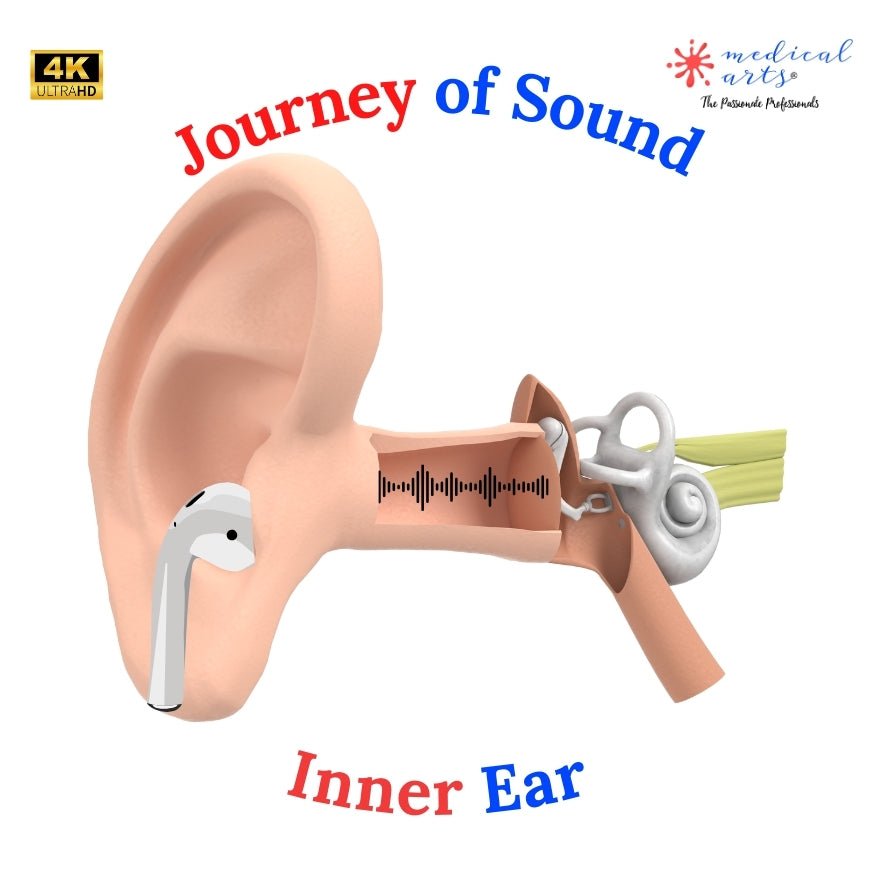Article still under development 🚧
Journey of Sound.
Physiology of the inner ear.
Introduction
In our daily lives, earphones have become ubiquitous, providing a private soundscape for music, calls, or podcasts. Yet, the sound journey from these devices to our auditory perception is a marvel of physics and biology. This article delves into the intricate process, from the generation of sound in the earphones to its perception in our brains.
The Birth of Sound in Earphones
Sound in earphones starts as an electrical signal, like a coded message. Inside each earphone is a tiny part called a driver, usually the dynamic type. It's like a mini speaker. This driver's job is to decode the message and turn it into sound. It does this by moving back and forth fast, vibrating just like the skin of a drum. These vibrations push against the air, creating sound waves and ripples like throwing a stone in water. These waves then travel from the earphones into your ears. Imagine them as invisible sound ripples moving through the air. This is how your favourite songs or the voice of a friend on a call start their journey to reach your ears, all happening incredibly quickly and in a space no bigger than your earbuds.

Traversing the Ear Canal
When sound leaves the earphones, it travels into our ear canal, a small tunnel that leads to the eardrum. Think of this canal as a narrow hallway that carries the sound to a particular part of our ear. It's not just a simple tube, though. It acts like a natural amplifier, making certain sounds, especially those like people talking, a bit louder and more precise. This helps us hear voices better, even when there's a lot of noise around us.
Besides carrying sound, the ear canal has another important job: it protects our inner ear. Inside, earwax and tiny hairs work together like a security team. The earwax helps catch dust and small bits of dirt, while the hairs keep these unwanted guests from going deeper. So, while the ear canal seems like a path for sound, it's an integral part of our ear that helps us hear and stay healthy.
The Eardrum and Middle Ear Mechanics
Imagine the eardrum as a tiny drum skin inside your ear. When sound from your earphones reaches it, it starts to move back and forth, just like a drum skin when you hit it. This movement copies the sound's pattern.
Next, inside your ear, there are three tiny bones, the smallest in your body. These are called the malleus, incus, and stapes, but you can think of them as tiny hammers, anvils, and stirrups. They pick up the drumming from your eardrum.
These bones work together like a mini lever system. They make the vibrations from the eardrum stronger and pass them on to a part of your ear called the inner ear. This is where the real magic of hearing starts, turning these vibrations into sounds your brain can understand.
So, every time you listen to music through earphones, this incredible, tiny drum and lever show is happening inside your ears!
Entering the Inner Ear
The stapes connect to the cochlea, a snail-shaped, fluid-filled structure in the inner ear. The vibrations cause the fluid in the cochlea to move, stimulating thousands of tiny hair cells. These hair cells are tuned to different frequencies, and their movement generates electrical signals.
The Role of the Auditory Nerve
The electrical signals generated in the cochlea are carried to the brain by the auditory nerve. Each auditory nerve contains thousands of nerve fibres, each with signals from different cochlea parts. This organization allows the brain to interpret different frequencies as separate sounds.
Brain's Interpretation of Sound
Finally, these signals reach the auditory cortex in the brain, where they are interpreted as sound. This complex process involves not just the perception of pitch and volume but also the ability to locate the source of the sound and focus on specific sounds in noisy environments.
Conclusion
The process from earphone sound to auditory perception is a remarkable journey. It involves a sophisticated interplay of mechanical and neural processes. Understanding this journey highlights the wonders of human physiology and underscores the importance of protecting our hearing, an often underappreciated sense.

